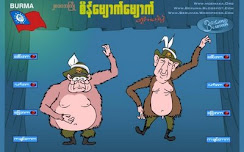A Burmese lawyer now in exile says authorities tortured evidence out of his clients.
Photo: AFP/ Armed security forces march down the streets of Rangoon during a crackdown on anti-government protests, Sept. 27, 2007.
BANGKOK—A Burmese lawyer who fled to Thailand to avoid jail after representing 11 anti-government protesters has said authorities tortured evidence from his clients that was used to convict them in connection with a bombing earlier this year.
“In this case, Yan Shwe, Zaw Zaw Aung, and U Myint Aye were arrested by police, and were mentally and physically tortured to obtain evidence that they had committed the crime,” Saw Kyaw Kyaw Min told reporters in Thailand.
“Evidence obtained in such a manner by the police was then used in court. In that case, I examined five witnesses before I fled the country,” he said, having fled to Thailand after weeks in hiding from the Burmese authorities.
Yan Shwe, Zaw Zaw Aung, and Myint Aye were sentenced last month in Rangoon’s Northern District Court to life in prison for allegedly planting a bomb in the Union Solidarity and Development Association (USDA) office in the city’s Shwe Pyitha township. The device exploded July 1 but no one was killed or injured in the blast.
The USDA is a government-sponsored social welfare group that serves as a civilian proxy for military interests. Members of the opposition say the USDA is often mobilized to put down anti-government protests.
Burma's courts have sentenced more than 200 political and labor activists, bloggers, journalists, and Buddhist monks and nuns to lengthy jail terms in recent months.
Flight to avoid jail
Saw Kyaw Kyaw Min, 28, worked as a lawyer in Rangoon, where he defended 11 members of the opposition National League for Democracy (NLD).
In October, the Hlaing Thaya township court in Rangoon sentenced him to six months in prison for contempt of court after he failed to intervene when his clients turned their backs on the judge to protest the manner in which they were being questioned.
Three of the defendants also sought to call Information Minister Gen. Kyaw Hsan as a witness, Saw Kyaw Kyaw Min said at the time, prompting another call from the judge for the lawyers to control their clients.
Saw Kyaw Kyaw Min and another lawyer, Nyi Nyi Htwe, appeared in court Oct. 23 with their clients, 11 youths who had staged a protest march in Rangoon on May 15 in which they wore t-shirts calling for the release of detained opposition leader Aun San Suu Kyi.
“The main reason I had to flee the country is that the authorities charged me under Penal Code 228,” or contempt of court,” Saw Kyaw Kyaw Min said.
“I was ready to face and defend the charges in court. As a matter of fact, I did go to court Oct. 27 to defend those charges, but they postponed the proceedings until Oct. 30. But then they issued orders and tried to arrest us on Oct. 29,” he said.
“That is why I became convinced that our legal system doesn’t have any trace of justice, and therefore I completely lost faith and trust in the system, and so I fled the country.”
“I can see that handing down long-term sentences to young students like Sithu Maung and Ye Myat Hein is intended to cut short the continuance of the next generation of young politicians. I can also see that giving long-term jail sentences to the 1988 generation of politically active leaders is intended to stop all political activities prior to the 2010 elections, which are to be organized by the government.”
Nyi Nyi Htwe, along with lawyers Aung Thein and Khin Maung Shein, was arrested and sentenced to terms of four to six months in prison on the same charges.
Legal hurdles
In a written statement made available to reporters, Saw Kyaw Kyaw Min described the difficulties facing lawyers who represent political prisoners.
The authorities, he said, often delay approval for lawyers to represent prisoners; keep security officers in the room when lawyers and clients meet; fail to inform lawyers of court dates; direct judges, prosecutors, and prosecution witnesses; and improperly redact court records and transcripts.
New York-based Human Rights Watch, citing Saw Kyaw Kyaw Min’s account, sharply criticized Burma’s legal system and called for high-level intervention by Burma’s neighbors.
“The government locks up peaceful activists, sends them to remote prisons, and then intimidates or imprisons the lawyers who try to represent them," Elaine Pearson, deputy Asia director at Human Rights Watch, said.
"This abuse of the legal system shows the sorry state of the rule of law in Burma."
The New York-based organization, citing the Association of Southeast Asian Nations (ASEAN) Charter which entered into force Dec. 15, urged ASEAN to dispatch “an eminent independent legal team to monitor the trials and conditions of activists held in isolated prisons.”








